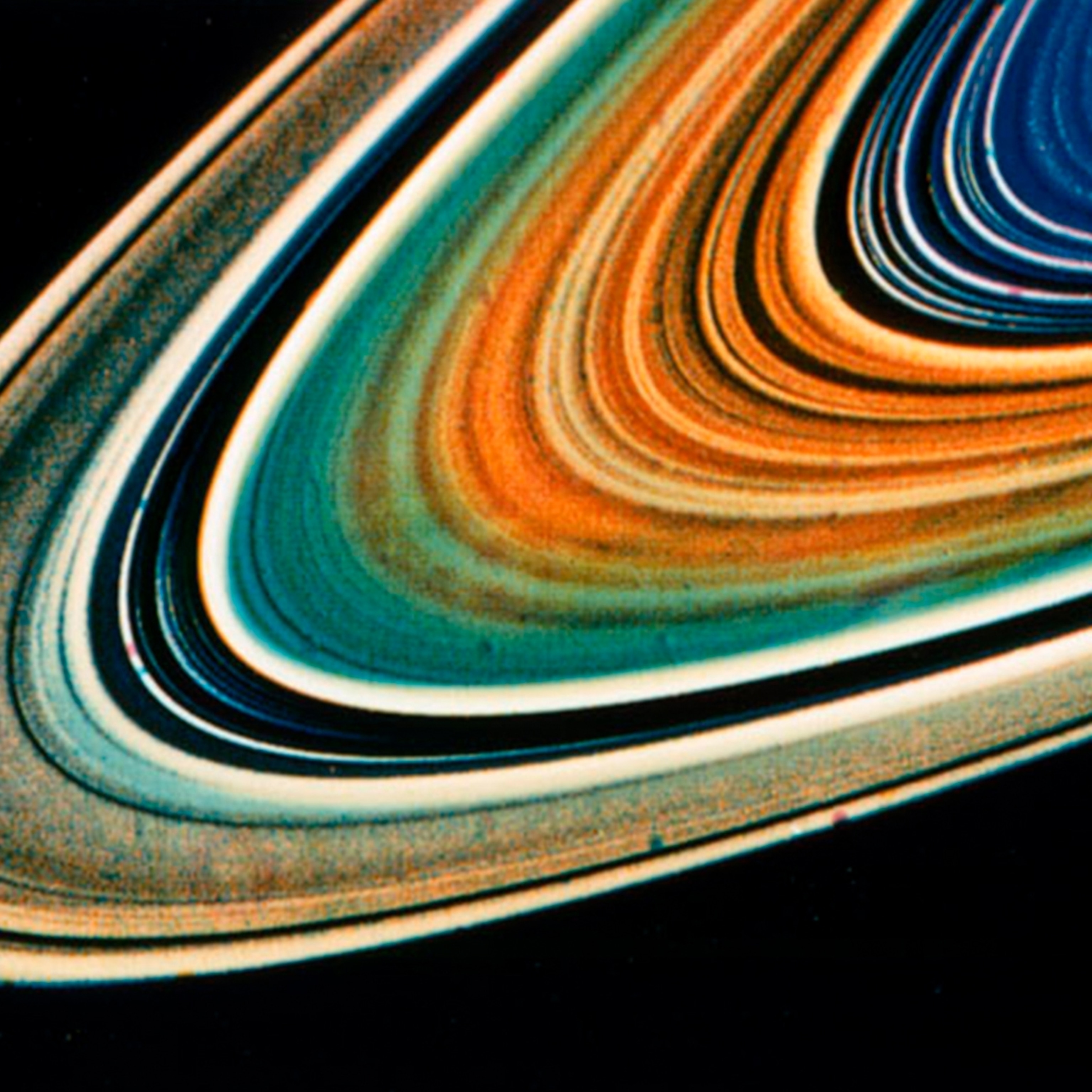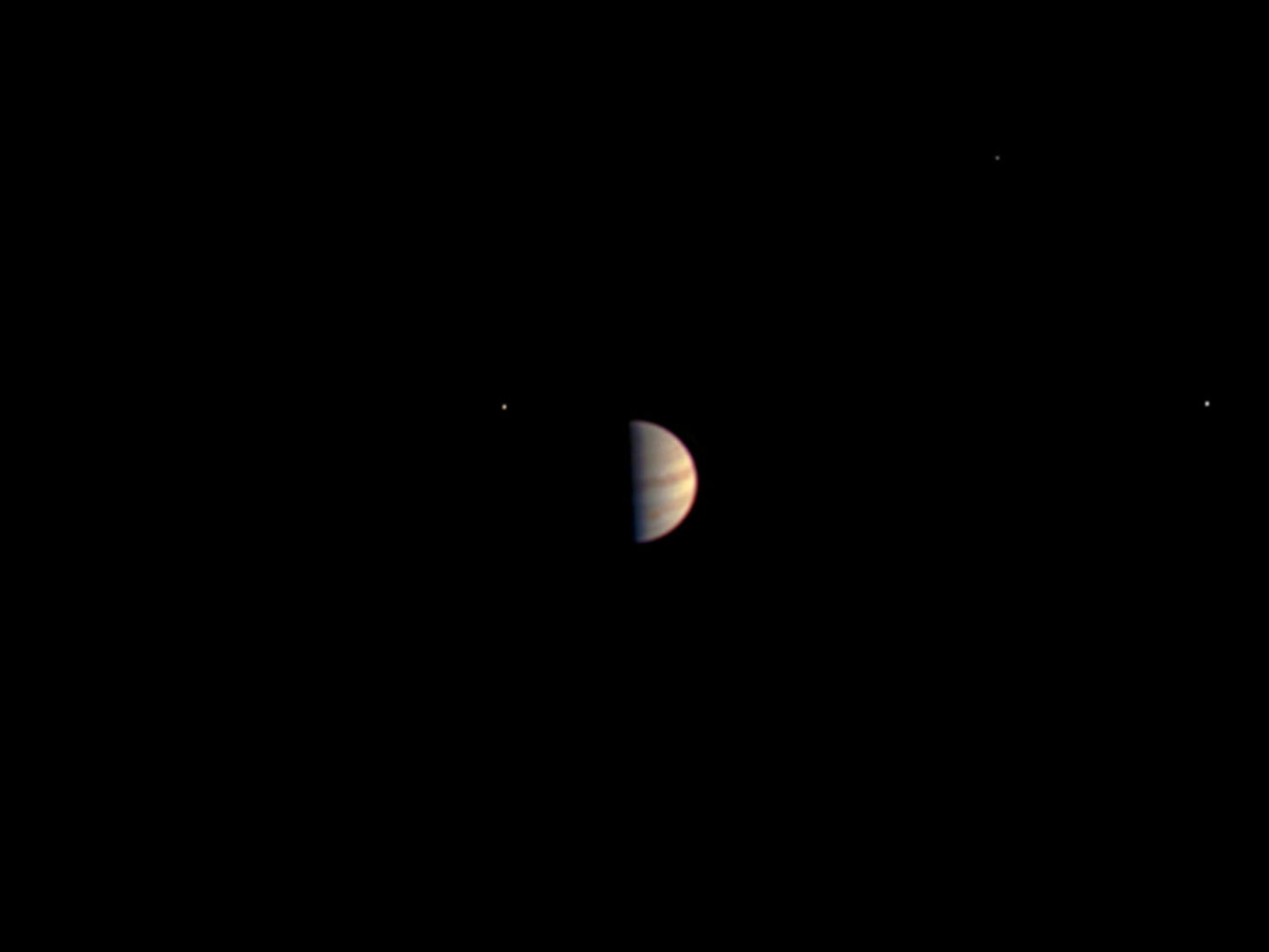
NASA's Juno Spacecraft Is Now Orbiting Jupiter
The probe completed a tricky maneuver on July 4 to settle into a long orbit around the giant planet and begin to unlock its mysteries.
“Welcome to Jupiter!” came the announcement from mission control just before midnight eastern time.

After a 35-minute engine burn, NASA’s Juno spacecraft has ceased orbiting the sun and is now in orbit around giant Jupiter. It was a do-or-die maneuver that saw the spacecraft sailing through lethal radiation belts and dodging dust slung into space by the planet’s intense gravity.
From here, the spacecraft will begin to peer beneath Jupiter’s clouds and study its mysteries.
“There’s a great feeling of relief in addition to that joy,” Michael Watkins, director of NASA’s Jet Propulsion Laboratory in California, said shortly after the announcement. “In some sense it’s the end of the voyage, but it’s the beginning of the science.”
That voyage took five years and covered 1.7 billion miles (2.7 billion kilometers). But the hardest part came at the journey’s end, when the spinning spacecraft’s engines needed to burn with laser-like precision to help slow Juno down so that it couldin order for become Jupiter’s newest—albeit temporary—satellite.
The engine burn lasted for 2,102 seconds, just one second off from pre-burn predictions (take note, airlines).
As Juno neared Jupiter, the spinning spacecraft started cartwheeling five times per minute, which helped stabilize it during orbit insertion. Then it turned away from the sun and put on the brakes.
After pulling into orbit, Juno slowed its spinning and turned back toward the sun to once again charge its batteries. Over the next weeks, the team will refine the spacecraft’s orbit and turn on its instruments.
“I‘m just so curious about the discoveries we can make, and learning about our beginnings, and what can Jupiter tell us about how the solar system was made,” says mission principal investigator Scott Bolton of the Southwest Research Institute.
Safety in Slumber

As many travelers would probably prefer, NASA’s Juno spacecraft slept through the most dangerous part of its journey to Jupiter.
Launched in August 2011 (after a slight delay caused by an errant boat near Cape Canaveral), solar-powered Juno is equipped with an array of instruments designed to solve the mysteries of the giant planet’s interior and evolution.
But a few days out, the spacecraft entered Jupiter’s intense magnetic field—a behemoth structure more than 3 million miles (4.8 million kilometers) wide, on average. The only instrument that was awake during its approach was a star tracker, which helps keep the craft on course.
The spacecraft’s cameras and other science instruments were powered down, and as Juno neared its target, that star tracker also had to blink off, leaving the spacecraft flying blind.
Paradoxically, it was the only way to keep Juno safe.
To pull into orbit, Juno had to fly a Jovian gauntlet that exposed it to belts of radiation unlike anything any spacecraft has ever encountered.
“The trickiest thing about that is we have no idea what we’re going to face, because nobody’s been there before,” says the mission’s lead radiation monitor, Heidi Becker of NASA’s Jet Propulsion Laboratory in California.
“When you sail into terra incognita, that is always going to make you sit on the edge of your seat, because you don’t really know for sure what you’re facing.”

Jupiter’s magnetic field is so strong that it catapults surrounding electrons to light speed, creating a deadly hailstorm of charged particles more than capable of annihilating sensitive electronics.
As a result, Juno is heavily armored, outfitted with a 400-pound (180-kilogram) titanium shield around its computers and smaller shields protecting its instruments. To minimize the risk of any damage happening early in the mission, Juno’s team decided to shut down the instruments during the delicate process of getting the probe into orbit.
“We won’t be seeing the radiation, because all of the instruments that can tell us about it are already off,” Becker says.
Music of the Spheres
Now that the orbital insertion is complete, the craft will fly 33 science orbits around Jupiter over the next 20 months. During this time, it will dip in and out of the belts, exposing its instruments to the equivalent of a hundred million dental X-rays and almost certainly causing damage and degradation.

But the most crucial maneuver was a 35-minute engine burn that began at 11:18 p.m. ET on July 4. To end up in orbit, this burn had to happen precisely on time, for the right amount of time. Otherwise, Juno would have sailed right past the planet and the mission would have been moot.
The only way the team knew all had gone well was dozens of tones sent back to Earth announcing the completion of each step in the orbit insertion. Traveling at the speed of light, these tones take 48 minutes to arrive.
That means when the tone announcing the beginning of the engine burn arrived at mission control, the burn was already been completed—and Juno was in orbit.
“We’ll be listening to the music,” Becker said a few days before arrival. “I think I’ll personally feel pretty good around 9 p.m. [Pacific time] Monday.”
When Juno’s instruments turn back on, it will be the first spacecraft to see Jupiter’s poles as it orbits the giant world, skimming its cloud tops and collecting data about what lies beneath the planet’s colorful, iconic bands and shrinking Great Red Spot.
Among the questions Juno could answer is what type of material is churning deep inside Jupiter and generating that immense, deadly magnetic field, which is capable of producing magnificent auroras. According to some theories, that material could be a strange, exotic form of molten hydrogen. The science team also hopes to find out how much water is tucked into Jupiter’s interior.
“That is crucial to understanding the weather and storms we see,” says Amy Simon of NASA’s Goddard Space Flight Center in Maryland. “This also ties to how and where Jupiter formed, which is interesting in terms of understanding all the exoplanets we have now found.”
After all, of the thousands of planets discovered so far beyond our solar system, many are around the size of Jupiter or larger, including worlds called hot Jupiters that, unlike any of our gas giants, are in sweltering orbits very close to their host stars.
At the end of its mission, Juno will plunge through the Jovian clouds. Its dramatic demise means the craft won’t accidentally contaminate any of the planet’s moons with hitchhiking Earthly life-forms—specifically Europa, an intriguing icy moon that will be the target of NASA’s next mission to the outer planets, slated to launch in the 2020s.
Follow Nadia Drake on Twitter.
Related Topics
You May Also Like
Go Further
Animals
- We finally know how cockroaches conquered the worldWe finally know how cockroaches conquered the world
- Move over, honeybees—America's 4,000 native bees need a day in the sunMove over, honeybees—America's 4,000 native bees need a day in the sun
- Surveillance Safari: Crowdsourcing an anti-poaching movement in South Africa
- Paid Content
Surveillance Safari: Crowdsourcing an anti-poaching movement in South Africa - Fireflies are nature’s light show at this West Virginia state parkFireflies are nature’s light show at this West Virginia state park
- These are the weird reasons octopuses change shape and colorThese are the weird reasons octopuses change shape and color
- Why young scientists want you to care about 'scary' speciesWhy young scientists want you to care about 'scary' species
Environment
- Wildlife wonders: connecting a new generation with South Africa’s iconic species
- Paid Content
Wildlife wonders: connecting a new generation with South Africa’s iconic species - These images will help you see coral reefs in a whole new wayThese images will help you see coral reefs in a whole new way
- What rising temperatures in the Gulf of Maine mean for wildlifeWhat rising temperatures in the Gulf of Maine mean for wildlife
- He’s called ‘omacha,’ a dolphin that transforms into a man. Why?He’s called ‘omacha,’ a dolphin that transforms into a man. Why?
- The northernmost flower living at the top of the worldThe northernmost flower living at the top of the world
History & Culture
- Should couples normalize sleeping in separate beds?Should couples normalize sleeping in separate beds?
- They were rock stars of paleontology—and their feud was legendaryThey were rock stars of paleontology—and their feud was legendary
- Scientists find evidence of ancient waterway beside Egypt’s pyramidsScientists find evidence of ancient waterway beside Egypt’s pyramids
Science
- Can a spoonful of honey keep seasonal allergies at bay?Can a spoonful of honey keep seasonal allergies at bay?
- Scientists just dug up a new dinosaur—with tinier arms than a T.RexScientists just dug up a new dinosaur—with tinier arms than a T.Rex
- Why pickleball is so good for your body and your mindWhy pickleball is so good for your body and your mind
- Extreme heat can be deadly – here’s how to know if you’re at riskExtreme heat can be deadly – here’s how to know if you’re at risk
- Why dopamine drives you to do hard things—even without a rewardWhy dopamine drives you to do hard things—even without a reward
Travel
- The ‘Yosemite of South America’ is an adventure playgroundThe ‘Yosemite of South America’ is an adventure playground
- These farmers make it possible for hikers to access Alpine trailsThese farmers make it possible for hikers to access Alpine trails
- A guide to Philadelphia, the US city stepping out of NYC's shadowA guide to Philadelphia, the US city stepping out of NYC's shadow
- How to make perfect pierogi, Poland's famous dumplingsHow to make perfect pierogi, Poland's famous dumplings







